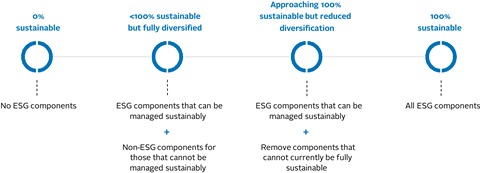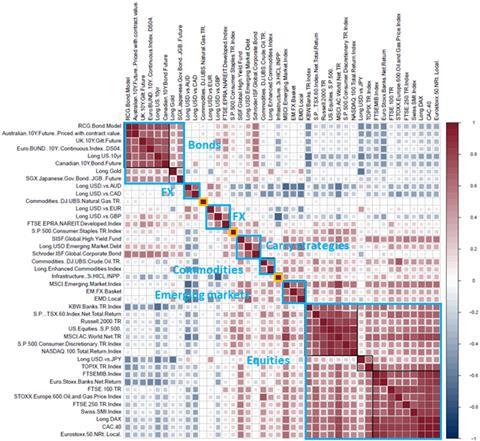Case study by Schroder Investment Management
- Organisation type: Investment manager
- Region of operation: Global
- Assets under management: £470.5bn
Why creating a sustainability budget can help multi-asset investors reach their ESG goals
Whatever the reasons for considering environmental, social and governance (ESG) criteria and sustainability in a portfolio, managing this exposure across multiple asset classes is significantly more complicated than managing it within a single asset class.
As asset owners journey towards 100% sustainable assets, there are several important decisions they will need to make including:
- How much sustainability do they want to incorporate in their overall assets? Will it be applied to just some components/asset classes/funds, all components and/or asset allocation?
- How will sustainability be implemented? For example, negative screening, best in class or ESG integration?
- If sustainability is applied at the asset allocation level, how should this be incorporated?
- We believe that asset owners are already juggling multiple priorities – the amount of risk that they want to take to achieve the outcome that they need and the amount of time they must govern the assets.
We have introduced the idea of a ‘sustainability budget’ which allows asset owners to manage these somewhat competing priorities. A sustainability budget is measured as the percentage of capital in the portfolio that is allocated to sustainable assets. This clearly allows some flexibility in the definition of what is classified as sustainable, which the asset owner will need to agree with the asset manager.
Given our experience with making longer and shorter term asset allocation decisions and integrating ESG throughout our multi-asset process, we thought it would be helpful to share our experience of the interlinked nature of sustainability, risk and time/resource/effort taken to govern assets in a portfolio.
How we manage multi-asset portfolios to meet ESG aims and limit risk
Building a multi-asset portfolio that meets the sustainability budget set by the asset owner depends in large part on the availability of sustainable components. Where components are unavailable for all of the asset classes in the asset owner’s strategic asset allocation, a compromise will have to be made between the extent of diversification and sustainability in the portfolio. This means that the asset owner will need to decide how far along the sustainability spectrum they want to be (as shown in Figure 1).
Figure 1 – The journey along the sustainability spectrum

The most important part for us in managing multi-asset portfolios is to understand the impact of including sustainability objectives on our ability to diversify the portfolio and still meet the short-term risk limits set by our clients. For example, if we are asked to target ‘lower carbon intensity1 than the index’ as a sustainability objective, this would impact the investments in which we could invest. If we were given a sustainability objective of ‘Do no harm’, this would likely restrict the investments further.
It is our belief that it is currently difficult to find sustainable options across all potential asset classes. By limiting the universe from which investments are selected, the asset owner needs to be cognizant of the impact on diversification.
For example, if commodities (which are often regarded as more difficult to manage from an ESG perspective) are removed from the opportunity set for a multi-asset portfolio, the impact could be significant, depending on the size of the allocation and correlation with other asset classes.
In a similar way, the impact of each type of investment asset (bond, equity, commodity etc.) should be analysed before it is removed or limited in a portfolio’s construction. To understand how the removal of a component can affect the overall portfolio, we have analysed the correlation between different asset types in a typical multi-asset portfolio.
Figure 2 shows a correlation matrix for a hypothetical portfolio that contains 42 positions across multiple asset classes including equities, bonds, currencies and alternatives, regions, and sectors. However, those 42 distinct positions collapse down to just 10 clusters (shown by blue squares). If, for example, we were to remove just one of these blue risk clusters on sustainability grounds, the portfolio would be much more highly concentrated in the other clusters. Clearly, the impact on portfolio diversification of simply excluding an asset class from the investment opportunity set is greater than you would initially believe.
Figure 2 – Truly understanding the impact on risk helps to understand the compromises to diversification

Example: Governance and risk budgeting
A governance budget is the time, expertise and commitment available to manage the assets. Good governance has been demonstrated to ‘make a significant incremental difference to value creation as measured by long-term risk-adjusted rates of return’.2 The further along the sustainability spectrum that assets are managed, the larger the governance budget required to manage those assets in a sustainable way.
Even at the ‘screened’ end of the spectrum, initial thought/expertise needs to go into defining the screens, assessing the impact of screening out certain industries and companies, and ensuring that the analysis is maintained and reviewed. In addition, as the number of asset classes managed sustainably increases, so a larger governance budget will need to be assigned (see Figure 3). Further governance budget will be required if the asset allocation is also required to incorporate sustainability.
Figure 3 – The governance budget will need to increase as asset owners move further up the sustainability spectrum

Source: Schroders, for illustration only. Screened – Negative screening beyond statutory requirements. Integrated – ESG analysis is a building block of the investment process. It is systematic and there is a commitment to engagement and stewardship. Sustainable – ESG analysis is a cornerstone of the investment process. The resulting portfolio has a strong sustainability profile, focused on generating returns that can truly be maintained over the long term.
Risk budgeting is a way of ‘incorporating risk and return information to produce more efficient investment decisions‘3. When the interaction between the risk budget and the sustainability budget is considered, the impact is less clear. Intuitively, as fewer companies and asset classes are included on sustainability grounds, it follows that less breadth in the portfolio will result in a higher risk profile. However, it could also be argued that by focusing on companies that are likely to be positive from a sustainability perspective, risk in the portfolio will be reduced over the longer term.
Over the shorter term though we can observe that portfolio risk increases when asset classes such as alternative assets (which are more difficult to implement in a sustainable way) are removed.
Portfolio risk is made up of two components: the risk of the individual components (standalone risk), and the relationship between the components (diversification benefit). In aggregate, the former will always have a positive contribution to risk, while the latter will reduce risk. Starting with a simple multi-asset portfolio (Figure 4), we can observe that diversification reduces and standalone risk increases (resulting in higher portfolio risk) when these components are removed from the portfolio (Figure 5).
Figure 4 – Portfolio risk is made up of individual component risks and the diversification benefit

Figure 5 – Removing alternatives from the portfolio reduces diversification benefit

Data as at 28 February 2019. The starting strategic asset allocation portfolio is made up of 40% equities (split ¾ developed, ¼ emerging), 25% global government bonds, 5% investment grade corporate bonds, 5% high yield, 5% emerging market debt, 5% cash and 15% alternatives (5% property, 5% hedge funds, 5% commodities).
As can be seen, removing asset classes in pursuit of a high sustainability budget can be expensive in terms of the short-term risk measures that asset owners typically use. It is important to consider ESG in the context of the total portfolio, recognising the interlinked nature of the sustainability budget, the risk budget and the governance budget.
Important information
The views and opinions contained herein are those of the Multi-Asset Economics, Strategy and Research team, and may not necessarily represent views expressed or reflected in other Schroders communications, strategies or funds.
This material is intended to be for information purposes only. The material is not intended as an offer or solicitation for the purchase or sale of any financial instrument. The material is not intended to provide and should not be relied on for accounting, legal or tax advice, or investment recommendations. Reliance should not be placed on the views and information in this document when taking individual investment and/or strategic decisions. Past performance is not a guide to future performance and may not be repeated. The value of investments and the income from them may go down as well as up and investors may not get back the amounts originally invested. All investments involve risks including the risk of possible loss of principal. Information herein is believed to be reliable but Schroders does not warrant its completeness or accuracy.
Some information quoted was obtained from external sources we consider to be reliable. No responsibility can be accepted for errors of fact obtained from third parties, and this data may change with market conditions. This does not exclude any duty or liability that Schroders has to its customers under any regulatory system. Regions/sectors shown for illustrative purposes only and should not be viewed as a recommendation to buy/sell.
The opinions in this document include some forecasted views. We believe we are basing our expectations and beliefs on reasonable assumptions within the bounds of what we currently know. However, there is no guarantee than any forecasts or opinions will be realised. These views and opinions may change.
Any data has been sourced by us and is provided without any warranties of any kind. It should be independently verified before further publication or use.
Third party data is owned or licenced by the data provider and may not be reproduced, extracted or used for any other purpose without the data provider’s consent. Neither we, nor the data provider, will have any liability in connection with the third party data.
To the extent that you are in North America, this content is issued by Schroder Investment Management North America Inc., an indirect wholly owned subsidiary of Schroders plc and SEC registered adviser providing asset management products and services to clients in the US and Canada.
For distributing in the UK, this content is issued by Schroder Investment Management Limited, 1 London Wall Place, London, EC2Y 5AU. Registered No. 1893220 England. Authorised and regulated by the Financial Conduct Authority. For your security, communications may be taped or monitored. CS2695. RI000037
References
1 Carbon intensity represents Scope 1&2 emissions relative to each $1mn of sales.
2 Best practice pension fund governance, Clark and Urwin, Journal of Asset Management, May 2008
3 Risk budgeting in pension investment, Urwin, Breban, Hodgson and Hunt, British Actuarial Journal 2001












